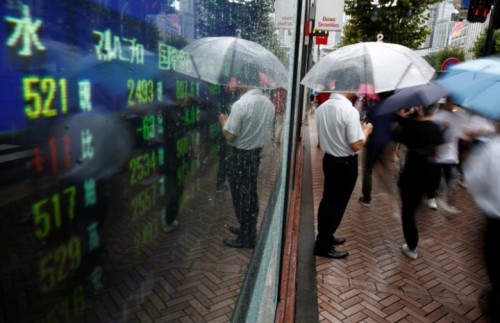Sterling recoups some losses after 10 percent plunge; stocks slip

LONDON- Sterling recouped some losses after plunging almost 10 percent on Friday amid growing fears of a "hard" exit by Britain from the European Union that sent a shiver through world stocks markets ahead of U.S. jobs data.
The pound nosedived from $1.2600 to $1.1378 in a matter of seconds as one point in Asia after crashing through key support levels, triggering a wave of selling. The lowest of the trades was later canceled.
But it quickly bounced and it was around 1.2455 by 0900 GMT, still down about 1.3 percent from late U.S. levels and leaving traders feeling bruised and a little confused in the absence of any major news overnight.
"This was even a bigger move than what we saw after the Brexit vote. There were almost no offers, no bids when this happened," said a trader at a European bank in Tokyo.
The plunge in the pound, which looks like being roughly 4 percent for the week overall, lifted London's FTSE as many of its firms are looking at bumper returns when their overseas earning are exchanged back into sterling.
Continental European stocks fell though with the pan-European STOXX 600 index down by 0.5 percent with Germany's DAX and France's CAC both down similar amounts.
The STOXX 600 has fallen by around 7 percent since the start of 2016.
The pound has come under renewed pressure as fears grow that Britain's divorce from the EU will be messier and costlier for the economy than expected. UK Prime Minister Theresa May on Sunday set a March deadline for the formal departure process from the EU to begin.
"The whole thing's been on a precipice since Sunday, since Theresa May (pointed to) March Brexit negotiations, but the selling has been very substantial so you can only think its been part of that general punishment of the pound for Brexit," said Sean Callow, senior currency strategist at Westpac.
"I think we've underestimated how many people had money positions for a very wishy-washy Brexit or even none. May's comments have really just started the cleanout and we just haven't seen any sign of bouncing."
While sterling's move broadly coincided with some news reports that Britain's separation from the euro zone may be a tough process, some traders blamed it on a possible a "fat finger" error triggering automatic stop-loss orders.
"A few stops got triggered in early trading and once cable broke 1.20, option barriers sent it lower," said Gerrard Katz, head of Asian FX sales and trading at Scotiabank said. "The broader market impact has been limited and cable should consolidate between the 1.20 and 1.25 levels."
POUND ROLL to PAYROLLS
Britain's finance minister Philip Hammond tried to reassure jittery markets on Thursday, saying the UK economy was fundamentally strong, but he acknowledged that next year will be "turbulent".
The sharp slide in the pound had little impact on other markets, though Asian stocks extended early losses as investors moved to the sidelines ahead of the U.S. monthly jobs report later in the day. If job creation is robust, it may cement the case for a U.S. rate increase in December.
Economists polled by Reuters forecast U.S. non-farm payrolls to increase by 175,000.
MSCI's broadest index of Asia-Pacific shares outside Japan and Japan's Nikkei both declined around 0.4 percent.
Stocks in Hong Kong were down 0.5 percent after data from China showed a third consecutive month of drop in foreign exchange reserves.
A disorderly reaction to possible U.S. interest rate hikes could disrupt capital flows and heighten asset price volatility in Asia, the International Monetary Fund said on Thursday.
Elsewhere in currency markets, the dollar edged down 0.1 percent against the yen to 103.80 after hitting its highest level in a month on Thursday.
The euro eased 0.3 percent to $1.1120, poised to shed 1 percent for the week.
The greenback held firm after data on Thursday showed the number of Americans filing for unemployment benefits unexpectedly fell last week to near a 43-year low, boding well for Friday's closely-watched payroll data.
Interest rate futures are now pricing in about a 65 percent chance of a rate hike by December, compared to less than 50 percent late last month.
The 10-year U.S. Treasuries yield hit a three-week high of 1.746 percent on Thursday before easing slightly to 1.73 percent on Friday.
Gold hit a 3-1/2-month low of $1,252 per ounce, having declined 5 percent on the week. It last stood at $1,258.8.
Silver has slumped more than 10 percent so far this week to hit a four-month low of $17.1525 per ounce.
Oil prices steadied after U.S. crude broke through $50 a barrel overnight, spurred by an informal meeting among the world's biggest producers on output cuts and falling U.S. crude inventories.
U.S. crude futures were little changed at $50.53, just below Thursday's four-month high of $50.63, Brent was up 0.4 percent at $52.70 and heading for a year high and its second consecutive rise of around 7 percent. -Reuters







